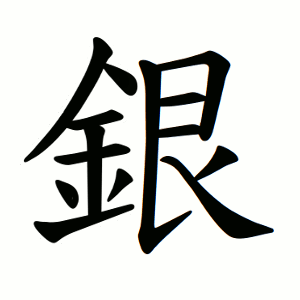銀
- silver;
- silver-colored;
Etymology
Usage in Korean
銀貨 (은화) — silver coin
白銀 (백은) — pure silver
銀河 (은하) — the Milky Way (“river of silver”)
銀髮 (은발) — silver hair, gray hair
銀行 (은행) — bank (lit. “silver house”)
銀幕 (은막) — silver screen (cinema)
Words that derived from 銀
Additional notes
Silver was historically a major medium of exchange in China and other cultures, hence 銀 is closely tied to the idea of currency.
The Milky Way’s East Asian name 銀河 highlights the bright, silvery-white appearance of the starry river.
In modern East Asian languages, 銀 frequently appears in compounds related to money and finance (銀行, 銀行券).
Figuratively, silver (銀) often symbolizes purity, brightness, and value, second only to gold (金).
